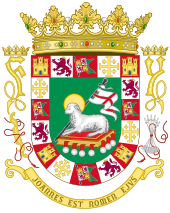Puerto Rico coat of arms
| Coat of arms of the Free State of Puerto Rico | |
|---|---|

|
|
| Details | |
| Alternative names | Estado Libre Asociado de Puerto Rico ( span. )
Commonwealth of Puerto Rico ( eng. ) |
| Authorized to use the coat of arms | Puerto Rico Free State |
| Introduced | 1976 (1511 & 1905) |
| Motto (motto) | Joannes Est Nomen Ejus ( Latin for "His name is Johannes") |
| use | The coat of arms is used as a seal on official documents. |
The coat of arms of Puerto Rico ( Spanish Escudo de Puerto Rico ) was granted by the Spanish Crown in 1511 and is one of the oldest coats of arms still in use in North and South America. The Free State of Puerto Rico is a suburb of the United States .
Blazon
The coat of arms shows a lying sheep with a halo and church flag as Agnus Dei in the green coat of arms shield with red and white board on a red closed book with gold pages and seven silver seals hanging on red strings .
Change the white board piece a golden Jerusalem Cross as beseitetes cross potent with a blue rotbewehrten and rotgezungten gold-crowned lion . A golden fort with three tinned towers and blue windows with a red and white square flag with a golden flagpole change in the red part of the board . The lion and the castle are repeated on the flag.
A golden crown of leaves rests on the shield . The right of the shield a golden F and left an equally colored Y . Both letters are crowned with gold. At the base of the shield on the right a golden yoke and on the left a bundle with five golden arrows pointing downwards.
A silver ribbon below the shield with the motto in Latin black capital letters "JOANNES EST NOMEN eJus". (His name is John, Lk. 1.63).
meaning
The central motif refers to the Revelation of John , where Christ as the innocent sacrificed Lamb of God is the only one able to open God's seven-fold sealed book , which triggers the end of the world. Book and lamb are depicted in the iconography that has become common since the Middle Ages : the book as a modern book ( codex ), not as a scroll, the lamb not with seven horns and eyes as in the original text, but according to nature, with a church flag and a halo fitted.
With the exception of this central motif and the motto, all heraldic symbols refer to the "Catholic kings" Isabella of Castile and Ferdinand of Aragón : the castle as the coat of arms of Castile , the lion as the coat of arms of León have been part of the Spanish royal coat of arms since their time ; At that time, the initials Ferdinand and Isabellas as well as yoke and bundle of arrows were included, and the Kingdom of Jerusalem , represented by the fivefold cross, was claimed by Ferdinand and included in the coat of arms after Isabella's death in 1504. At the time of these kings, Puerto Rico was discovered in 1493 and this coat of arms was first awarded in 1511; soon after independence it was reintroduced in 1905 and changed to its current form in 1976. The motto refers to John the Baptist , the namesake of the island.
use
The traditional coat of arms is used on official seals, but religious elements have been removed. The lamb's halo has been removed from the seal and the red cross on the banner it carries has been removed. The seals of the book (which previously symbolized the book of Revelation) have been removed. The official seal of the governor of Puerto Rico is based on the official state seal of the President of the United States . There are different variations of the seal.
There are different seals for each area of the Puerto Rican government.
Web links
- Flag and coat of arms of Puerto Rico near the city of San Juan (Spanish)
- Coat of arms of Puerto Rico at topuertorico.org (English)








